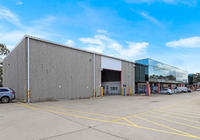
With residential property prices declining, is it time to invest in commercial real estate?
Eliza Owen
Analysis
Residential markets across Australia are well into a downswing.
Sydney dwellings are leading the decline, sitting 7 per cent below the peak median sale price in June last year. Melbourne dwellings have followed, with median prices down 5.2 since the market peak in December.
Domain forecasts slow growth in the Australian property market for 2019, before seeing a modest rebound in 2020. The median sale price in Australian houses is expected to increase just 1 per cent next year, while units may see an increase of just 2 per cent.
But demand for assets, with the potential to appreciate, remains high. Resident estimated population data suggests 1.3 million baby boomers will reach retirement age over the next five years.
Young Australians are also keen to buy a home, or at least invest in one, as it is considered increasingly vital for a comfortable retirement.
This raises the question: With residential property now well into its downturn, are the prospects for commercial property better?
Looking at some key indicators of demand, it seems that the commercial real estate segment as a whole is softening with the residential market.
However, given the diversity of building types within commercial real estate, there are a few asset types which stand to go against the downswing trend.
What are the experts saying?
Various indicators suggest that when residential property is booming, commercial real estate markets will generally rise as well.
The graph below shows the movement of two confidence indices over time – one for residential real estate, the other for commercial.
The National Australia Bank (NAB) Residential Property Index reflects growth expectations in the residential market. For commercial, the Royal Institute of Chartered Surveyors (RICS) produces an index of capital growth expectations.
The IMF has also used this index to support the idea that residential and commercial growth move together.
Each index is based on a survey of commercial or residential real estate professionals. The capital growth outlooks tend to move together for residential and commercial, though expectations for commercial real estate seem to be elevated.
Both of the confidence indices show a decline around December 2017. This is the same period Domain data indicated growth in the residential market had peaked nationwide.
Both residential and commercial real estate have some shared growth drivers. Growth in population, increases in employment and cheap credit are all factors that can drive up the value of both commercial and residential assets at the same time.
An example of this is how the cheap credit environment has affected commercial and residential real estate in the past few years.
Since 2011 the Reserve Bank has lowered the cash rate 12 times, largely because of the onset of the GFC and the end of the mining boom. The cash rate sank to 1.5 per cent, where it has stayed for 2 years.
This is one of the main reasons cited for the housing boom. Cheaper money meant people were able to bid up the value of houses and units.
Meanwhile, a similar trend arose in the commercial market. The low cash rate meant that high levels of capital were available to drive up the price of commercial real estate assets. Low interest repayments also increased tolerance for relatively low rental yields.
This would explain why capital growth sentiments for both residential and commercial real estate remained elevated between 2016 and 2017, as the cash rate reached a record low.
While houses and units across the board are expected to undergo declines or lower growth rates, there are still some strengths in the commercial real estate environment.
Commercial real estate: what’s hot and what’s not
The problem with trying to assess commercial real estate as one market, is that commercial properties are wildly different in characteristic, size and function.
The RICS commercial property monitor highlights this diversity in growth expectations among different asset types. The September 2018 result showed that the aggregated index for commercial real estate growth expectations was 10, down from 17 in the previous quarter.
This suggests overall, growth expectations for the sector were not as high.
However, when disaggregating the results, the index ranged from a positive 33 in office sentiment, to -23 in retail.
The divergence of growth in different asset types is also demonstrated in the views per listing on Commercial Real Estate. The year-on-year change in views per listing is featured below.
Industrial real estate is the asset best weathering the storm of tighter credit conditions and subdued investor demand. This is explored in further detail below. Industrial real estate saw a 31 per cent increase in the views per listing over the year to September, compared with a negative 10 per cent in retail views.
The weaker outlook for retail property is unsurprising, as people are buying less, and visiting shops less.
The latest economic data from the Australian Bureau of Statistics suggests annual trend growth in household consumption has been below average since December 2011.
Low levels of growth in household consumption have likely resulted from low wages growth. Annual growth in wages sat at a record low 1.9 per cent over 2017, and has lifted to just 2.3 per cent in the year to September.
Consumption is also increasingly moving online, as households seek added convenience and lower prices.
Estimates from the ABS suggests online retail made up a record 5.9 per cent of total retail turnover in Australia for October.
These economic indicators point to fewer retail visits, and fewer businesses opening up bricks-and-mortar stores. This in turn points to less competition for store spaces, reducing rental yields and property values.
However, this places warehouses in major metropolitan cities in particular demand. As the housing market enters a decline, industrial warehouses are increasingly diverging from the residential growth cycle.
Industrial real estate, particularly warehouses servicing storage and distribution, may have partially grown in popularity with the rise of online shopping.
Research of US commercial markets suggest that a significant portion of demand for storage and logistics space has come from increased ecommerce business.
Demand for warehouse buildings is evidenced in the latest building activity data. The June 2018 quarter saw a record $1.1 billion worth of warehouse construction commenced.
This is driven by more than $600 million worth of warehouse starts across NSW, as retailers and other businesses set up near the future Badgerys Creek Airport site.
Another interesting growth driver of industrial real estate, according to consensus among commercial real estate professionals, is that rapid development in residential real estate has crowded out space for industrial warehouses, particularly in geographically constrained cities like Sydney. With increased scarcity of industrial land, rental yields and demand for industrial property is rising.
Industrial warehouses are important for growing cities, as they are necessary for the local production, storage or distribution of goods.
For office assets, key indicators are business and labour market performance – particularly in service-based economies like Australia.
Until recently, business performance looked strong, and developers seemed bullish about office markets. This is particularly the case in Sydney and Melbourne where office vacancy rates remain tight, and high levels of office development are taking place.
However, industry professionals argue that office assets may be on the cusp of lower returns, as offices see a decline in rental yields amid rising prices.
Business growth indicators are slipping, which could indicate a decline in the demand for office assets.
Over the calendar year to date, the NAB business confidence index has trended down from 12 to 4, its weakest reading since July 2016.
Annual growth in full-time employment – a leading indicator of office vacancy – has also eased from its peak in December 2017 of 3.9 per cent, to 2.4 per cent in October 2018.
The housing market may also indirectly impact demand for office space. As Sydney and Melbourne housing markets decline, household consumption is expected to follow.
Reduced consumption of goods and services may lead to higher levels of unemployment, lower levels of hiring, and thus eventually ease demand for office space in Sydney and Melbourne.
It is increasingly clear that both residential and commercial real estate in Australia is seeing slower demand of the back of affordability constraints, tighter lending conditions and increased operating costs in the financial sector.
But the diversity of commercial real estate suggests there are still growth opportunities available. Scoping out different property types, talking to agents and following economic trends can make it easier to identify the building types most in demand.
Eliza Owen is a research analyst with Domain















